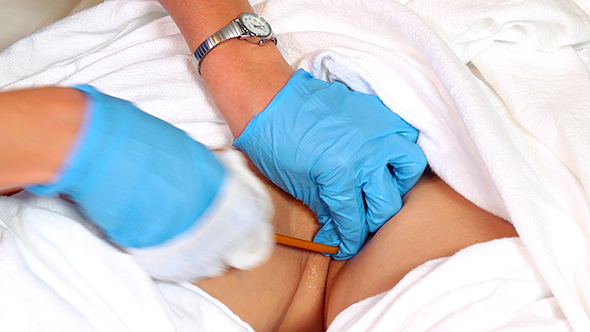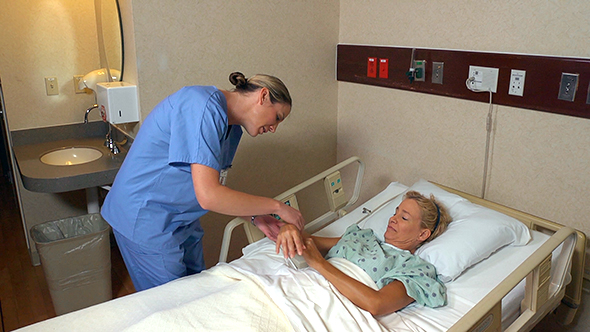Elimination Assistance
Select a Skill:
- » Helping the Person to the Commode
- » Applying Incontinence Products
- » Giving the Urinal
- » Giving the Bedpan
- » Applying a Condom Catheter
- » Giving Catheter Care
- » Emptying a Urinary Drainage Bag
- » Changing a Leg Bag to a Drainage Bag
- » Giving an Enema
- » Changing an Ostomy Pouch
Take the Review Test:

Purpose

- A catheter is a tube used to drain or inject fluid through a body opening. Inserted through the urethra into the bladder, a urinary catheter drains urine.
- A straight catheter drains the bladder and then is removed.
- An indwelling (retention or Foley) catheter is left in the bladder. Urine drains into a drainage bag. Tubing connects the catheter to the drainage bag.
- Catheterization is the process of inserting a catheter. It is done by a doctor or nurse. Some states and agencies let nursing assistants—with proper education and supervision—insert and remove catheters.
- Some people are too weak or disabled to use the bedpan, urinal, commode, or toilet. For them, catheters can promote comfort and prevent incontinence. Catheters can protect wounds and pressure ulcers from contact with urine. They also allow hourly urinary output measurements.
- Catheters are a last resort for incontinence. They do not treat its cause.
- Persons with catheters are at risk for urinary tract infections (UTIs).
Equipment
Roll cursor over items to see labels. For the purposes of clearly depicting the equipment, a barrier is not shown in this photo. When providing care, a barrier should always be placed on the surface before placing the equipment.

Bath blanket
Bath basin
Bath basin
Bath thermometer
Tape
Clip
Soap
Towel and washcloths
Gloves
Waterproof pad
Delegation
- Follow delegation guidelines. Before giving catheter care, obtain this information from the nurse and care plan:
- When to give catheter care—daily, twice a day, after bowel movements, or when vaginal discharge is present
- What water temperature to use for perineal care
- Where to secure the catheter—thigh or abdomen
- How to secure the catheter—tube holder, tape, or other device
- How to secure drainage tubing—clip, bed sheet clamp, tape, safety pin with rubber band, or other device
- What observations to report and record
- When to report observations
- What patient or resident concerns to report at once
Preparation

- Observe quality-of-life measures.
- Review the information under Delegation and Safety and Comfort.
- Practice hand hygiene.
- Collect the equipment.
- Cover the over-bed table with paper towels. Arrange items on top of them.
- Identify the person. Check the ID bracelet against the assignment sheet. Call the person by name.
- Provide for privacy.
- Fill the wash basin. Water temperature is about 105˚F (40.5˚C). Measure water temperature according to agency policy. Ask the person to check the water temperature. Adjust water temperature as needed.
- Raise the bed for body mechanics. Bed rails are up if used.
- Lower the bed rail near you if up.
Safety

- Follow the rules of medical asepsis. Follow Standard Precautions and the Bloodborne Pathogen Standard.
- Use caution if using a safety pin and rubber band to secure the drainage tubing to the bottom linens.
- Check the safety pin and rubber band.
- The safety pin must work properly. It must not be stretched out of shape. The rubber band must be intact. It must not be frayed or over-stretched.
- Do not insert the pin through the catheter.
- Point the pin away from the person.
Comfort
- The catheter must not pull at the insertion site. This causes discomfort and irritation. Hold the catheter securely during catheter care. Then properly secure the catheter.
- Make sure the tubing is not under the person. Besides obstructing urine flow, lying on the tubing is uncomfortable. It also can cause skin breakdown.
Procedure Video
Audio Description: OFFFollow-up Care

- Provide for comfort.
- Place the call light within reach.
- Lower the bed to its lowest position. Raise or lower bed rails. Follow the care plan.
- Clean, rinse, dry, and return equipment to its proper place. Discard disposable items. (Wear gloves for this step.)
- Unscreen the person.
- Complete a safety check of the room.
- Follow agency policy for soiled linen.
- Remove and discard gloves. Practice hand hygiene.
Reporting/Recording
- Report and record your observations, including:
- Signs and symptoms of a UTI, such as fever, chills, flank pain or tenderness, urine changes, changes in mental status or function, and urine leakage around the catheter
- Complaints of pain, burning, irritation, or the need to void (report at once)
- Crusting, abnormal drainage, or secretions
- Urine color, clarity (or cloudiness), and odor
- Particles or blood in the urine
- Drainage system leaks
Review Questions
Select the best answer.
1. When giving catheter care, which precaution should you take?
 Attach the drainage bag to the bed rail.
Attach the drainage bag to the bed rail. Be careful not to pull on the catheter during cleaning.
Be careful not to pull on the catheter during cleaning. Disconnect the catheter and drainage tubing and clean thoroughly.
Disconnect the catheter and drainage tubing and clean thoroughly. Keep the drainage bag at or above the level of the person’s bladder.
Keep the drainage bag at or above the level of the person’s bladder.
Select the best answer.
2. When giving catheter care, which technique is correct?
 Clean with soap and water, moving from the meatus down the catheter at least 4 inches.
Clean with soap and water, moving from the meatus down the catheter at least 4 inches. Clean with soap and water, washing the entire length of the catheter from the meatus to the drainage bag.
Clean with soap and water, washing the entire length of the catheter from the meatus to the drainage bag. Clean with an antibiotic solution, cleaning along the catheter for about 12 inches, moving from the meatus toward the drainage bag.
Clean with an antibiotic solution, cleaning along the catheter for about 12 inches, moving from the meatus toward the drainage bag. Clean with a disinfectant in a circular motion along the catheter for about 2 inches, moving from the drainage bag to the meatus.
Clean with a disinfectant in a circular motion along the catheter for about 2 inches, moving from the drainage bag to the meatus.
Select the best answer.
3. After cleaning the catheter, where should you secure it?
 To the outer thigh for a man
To the outer thigh for a man To the abdomen for a woman
To the abdomen for a woman To the inner thigh for a woman
To the inner thigh for a woman To the bed rail for a man or woman
To the bed rail for a man or woman
Select the best answer.
4. Which technique is a correct way to secure the drainage tubing?
 Clamp the tubing and tuck it under the person’s body.
Clamp the tubing and tuck it under the person’s body. Coil the tubing and secure it to the bottom linens with tape.
Coil the tubing and secure it to the bottom linens with tape. Coil the tubing and secure it with a safety pin pointing toward the person.
Coil the tubing and secure it with a safety pin pointing toward the person. Straighten the tubing and attach it to the top linens with a bed sheet clamp.
Straighten the tubing and attach it to the top linens with a bed sheet clamp.
Select the best answer.
5. Which observation may be a sign or symptom of a urinary tract infection (UTI) in a person with a catheter?
You have completed the Review Questions for this skill. To take the Review again select the Start Over button. To proceed to another skill select from the dropdown menu. Select the Home or Back button to proceed to the next section.

